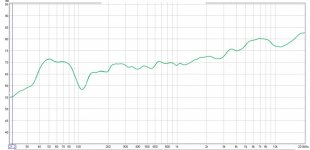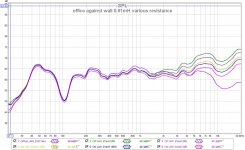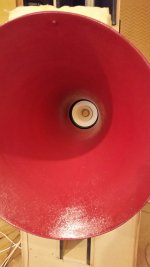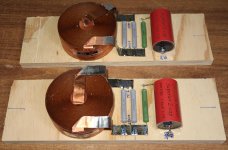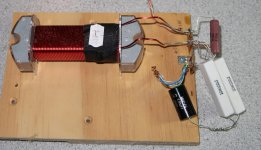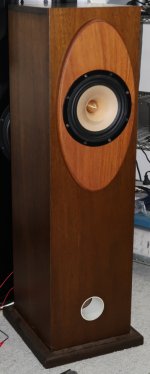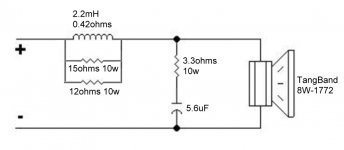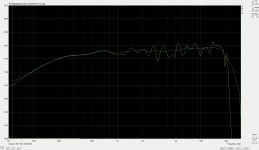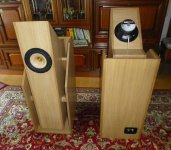Pass DIY Addict
Joined 2000
Paid Member
Here are some plots of my 1772 driver mounted in a 40L bass reflex box. Ignore the absolute numbers on the dB scale on the left, I did not adjust to accurately represent the sensitivity of the driver. The graphs do, however, show relative response according to frequency.
The first graph is just the driver in the box, no correction network, with 1/3 octave smoothing. The second graph shows the effect of a parallel 0.56mH + various resistances added in series with the driver (ignore the lowest purple plot on the right - no inductor was used here).
The third plot shows the same, but with a 0.81mH inductor and various resistances. The larger inductor tips the treble down a bit more than the smaller inductor for the same resistances.
I've settled on using a 0.56mH in parallel with 16R, placed in series with the driver. It's not perfect, but just two components tame the treble and make it a much nicer speaker.
The first graph is just the driver in the box, no correction network, with 1/3 octave smoothing. The second graph shows the effect of a parallel 0.56mH + various resistances added in series with the driver (ignore the lowest purple plot on the right - no inductor was used here).
The third plot shows the same, but with a 0.81mH inductor and various resistances. The larger inductor tips the treble down a bit more than the smaller inductor for the same resistances.
I've settled on using a 0.56mH in parallel with 16R, placed in series with the driver. It's not perfect, but just two components tame the treble and make it a much nicer speaker.
Attachments
What are people's impressions of the difference between the W8-1772 and W8-1808 ?
I know they are designed with a different Q and BL with the 1772 being designed more for back loaded horns and the 1808 for bass reflex use, however on first glance it appears that these are the only differences and that the cone/surround etc is the same.
Apparently not so! Comparing the specs on these two pages reveals some other differences:
Tang Band W8-1772 Fullrange Loudspeaker Measurements Data and Information Full Range
Tabg Band W8-1808 Fullrange Loudspeaker Measurements Data and Information Full Range
This is saying that the voice coil diameter (and therefore phase plug) of the 1772 is 32mm (already bigger than the 25mm voice coil in my Coral drivers) but the voice coil on the 1808 is an even bigger 38.5mm ?
You can't really tell this from photos, can anyone confirm this ?
Another difference reported at those links is the surround material, which it says is "impregnated cloth" for the 1772 (same as my Coral drivers) but "impregnated paper" for the 1808 - is this correct ?
I'm not a fan of paper surrounds, and it seems an odd choice for the version of the driver intended for bass reflex cabinets where excursion will be greater.
Again it's very difficult to tell from photos whether this difference in surround material is correct or not.
Is there any difference in the paper used for the cones or the size/shape of the whizzer cones ?
If I was planning to use these in a relatively small closed box and cross them over with a woofer at about 250Hz, the 1772 would appear to be the better choice of the two, as the over damped low Qes response would allow me to place it in a relatively small box (about 10 litres from memory, last time I simulated this) to cross it over at around 250Hz without a large peak at Fc, whereas the 1808 in such a tiny enclosure would have a relatively large peak at Fc that would require equalisation.
One other difference between to the two drivers appears to be that the 1772 has a shorting ring in the magnetic gap and the 1808 does not - I assume this based on the much, much lower inductance of the 1772, and the fact that the 1772 has a much more tilted up treble than the 1808, which would be consistent with a low inductance design...
Basically in the application I want to use them in I'm not planning to use them for bass, and want to have them work well for midrange and up in a fairly small enclosure, but I want extremely good dynamic performance from them from midrange up (hence not using a smaller driver) so I'm thinking the 1772 is the right choice between the two... ?
In theory you could still use a 1772 in a bass reflex enclosure simply by adding a series resistor - the correct value would bring the effective Qes of 1772 up to the same value as the 1808 and drop the sensitivity down to about the same as the 1808. That assumes the two drivers have the same Xmax and excursion capability though - do they ? Or does the 1808 have a greater Xmax ?
But you can't do the reverse and make the Qes lower and sensitivity higher on an 1808, making the 1772 the more versatile driver if you could only afford the one pair and wanted to try them in different applications...
I know they are designed with a different Q and BL with the 1772 being designed more for back loaded horns and the 1808 for bass reflex use, however on first glance it appears that these are the only differences and that the cone/surround etc is the same.
Apparently not so! Comparing the specs on these two pages reveals some other differences:
Tang Band W8-1772 Fullrange Loudspeaker Measurements Data and Information Full Range
Tabg Band W8-1808 Fullrange Loudspeaker Measurements Data and Information Full Range
This is saying that the voice coil diameter (and therefore phase plug) of the 1772 is 32mm (already bigger than the 25mm voice coil in my Coral drivers) but the voice coil on the 1808 is an even bigger 38.5mm ?
You can't really tell this from photos, can anyone confirm this ?
Another difference reported at those links is the surround material, which it says is "impregnated cloth" for the 1772 (same as my Coral drivers) but "impregnated paper" for the 1808 - is this correct ?
I'm not a fan of paper surrounds, and it seems an odd choice for the version of the driver intended for bass reflex cabinets where excursion will be greater.
Again it's very difficult to tell from photos whether this difference in surround material is correct or not.
Is there any difference in the paper used for the cones or the size/shape of the whizzer cones ?
If I was planning to use these in a relatively small closed box and cross them over with a woofer at about 250Hz, the 1772 would appear to be the better choice of the two, as the over damped low Qes response would allow me to place it in a relatively small box (about 10 litres from memory, last time I simulated this) to cross it over at around 250Hz without a large peak at Fc, whereas the 1808 in such a tiny enclosure would have a relatively large peak at Fc that would require equalisation.
One other difference between to the two drivers appears to be that the 1772 has a shorting ring in the magnetic gap and the 1808 does not - I assume this based on the much, much lower inductance of the 1772, and the fact that the 1772 has a much more tilted up treble than the 1808, which would be consistent with a low inductance design...
Basically in the application I want to use them in I'm not planning to use them for bass, and want to have them work well for midrange and up in a fairly small enclosure, but I want extremely good dynamic performance from them from midrange up (hence not using a smaller driver) so I'm thinking the 1772 is the right choice between the two... ?
In theory you could still use a 1772 in a bass reflex enclosure simply by adding a series resistor - the correct value would bring the effective Qes of 1772 up to the same value as the 1808 and drop the sensitivity down to about the same as the 1808. That assumes the two drivers have the same Xmax and excursion capability though - do they ? Or does the 1808 have a greater Xmax ?
But you can't do the reverse and make the Qes lower and sensitivity higher on an 1808, making the 1772 the more versatile driver if you could only afford the one pair and wanted to try them in different applications...
Last edited:
I had the 1772 over here and wanted to go OB.
The general rule is that the 1808 is better for OB, but... I had this big woofer that can go way up as a low end helper, so, I settled on a Harsch XO at 350Hz, which the 1772 could do, and didn't worry about the differences between the 1772 and 1808.
In my particular setup, the 1772 works. I'm not asking it to dig down low, then it can still deliver it's midrange sweetness without struggling with bass.
There's always more than one way to get to the good stuff. 🙂
The general rule is that the 1808 is better for OB, but... I had this big woofer that can go way up as a low end helper, so, I settled on a Harsch XO at 350Hz, which the 1772 could do, and didn't worry about the differences between the 1772 and 1808.
In my particular setup, the 1772 works. I'm not asking it to dig down low, then it can still deliver it's midrange sweetness without struggling with bass.
There's always more than one way to get to the good stuff. 🙂
I prefer the sonics of the 1808 over the 1772, but i feel both are overpriced and have more colouration than i like. Of the 8” whizzer cone drivers i have had thru here i like the SEAS FA22 and the Dayton PS220 best (very limited listening to the Dayton).
dave
dave
What are people's impressions of the difference between the W8-1772 and W8-1808 ?
I know they are designed with a different Q and BL with the 1772 being designed more for back loaded horns and the 1808 for bass reflex use, however on first glance it appears that these are the only differences and that the cone/surround etc is the same.
Apparently not so! Comparing the specs on these two pages reveals some other differences:
Tang Band W8-1772 Fullrange Loudspeaker Measurements Data and Information Full Range
Tabg Band W8-1808 Fullrange Loudspeaker Measurements Data and Information Full Range
This is saying that the voice coil diameter (and therefore phase plug) of the 1772 is 32mm (already bigger than the 25mm voice coil in my Coral drivers) but the voice coil on the 1808 is an even bigger 38.5mm ?
You can't really tell this from photos, can anyone confirm this ?
Another difference reported at those links is the surround material, which it says is "impregnated cloth" for the 1772 (same as my Coral drivers) but "impregnated paper" for the 1808 - is this correct ?
I'm not a fan of paper surrounds, and it seems an odd choice for the version of the driver intended for bass reflex cabinets where excursion will be greater.
Again it's very difficult to tell from photos whether this difference in surround material is correct or not.
Is there any difference in the paper used for the cones or the size/shape of the whizzer cones ?
If I was planning to use these in a relatively small closed box and cross them over with a woofer at about 250Hz, the 1772 would appear to be the better choice of the two, as the over damped low Qes response would allow me to place it in a relatively small box (about 10 litres from memory, last time I simulated this) to cross it over at around 250Hz without a large peak at Fc, whereas the 1808 in such a tiny enclosure would have a relatively large peak at Fc that would require equalisation.
One other difference between to the two drivers appears to be that the 1772 has a shorting ring in the magnetic gap and the 1808 does not - I assume this based on the much, much lower inductance of the 1772, and the fact that the 1772 has a much more tilted up treble than the 1808, which would be consistent with a low inductance design...
Basically in the application I want to use them in I'm not planning to use them for bass, and want to have them work well for midrange and up in a fairly small enclosure, but I want extremely good dynamic performance from them from midrange up (hence not using a smaller driver) so I'm thinking the 1772 is the right choice between the two... ?
In theory you could still use a 1772 in a bass reflex enclosure simply by adding a series resistor - the correct value would bring the effective Qes of 1772 up to the same value as the 1808 and drop the sensitivity down to about the same as the 1808. That assumes the two drivers have the same Xmax and excursion capability though - do they ? Or does the 1808 have a greater Xmax ?
But you can't do the reverse and make the Qes lower and sensitivity higher on an 1808, making the 1772 the more versatile driver if you could only afford the one pair and wanted to try them in different applications...
Go with the 1772, which was your first instinct anyway. I have had both, but prefer the 1772 for my application. Nothing wrong with the 1808 at all, it's just that the 1772 was a better fit for me. I run mine 250-8,000 Hz ~~ front loaded horn. Short transmission line for a back chamber, Filled with pink panther around the inside circumference, and the remaining "hole" filled with daycron.
Attachments
Update.
To those that noticed the sawtooth graphs I posted previously and suggested I was having measurement issues.
As you can see by today's sweep, a simple pc restart is all that was needed.
And that is literally all I did.
Gotta love technology 😀
The graph is 1/24 and 1/1 smoothing at 2.771ms gating.
Despite the 1db increase at the top end, their sounding pretty dam good.
Pics are of the original filter (Iron core and solen cap) and the replacement I built (Jantzen Wax coil and Superior Cap).
To those that noticed the sawtooth graphs I posted previously and suggested I was having measurement issues.
As you can see by today's sweep, a simple pc restart is all that was needed.
And that is literally all I did.
Gotta love technology 😀
The graph is 1/24 and 1/1 smoothing at 2.771ms gating.
Despite the 1db increase at the top end, their sounding pretty dam good.
Pics are of the original filter (Iron core and solen cap) and the replacement I built (Jantzen Wax coil and Superior Cap).
Attachments
Thank you.
I can't say what signature the steel core imparts as I didn't do a like for like test.
I can say the change in values made a substantial improvement.
And switching to the better parts made a very worthwhile improvement again.
Yes I know coils and caps are a heated debate for some.
But for me, there is no argument as to their effectiveness.
Overall there is still something not quite right.
But I wonder if it's something inherent with the driver, or the need for further tuning.
The area that to me isn't as I would like it is the midrange.
Since the filter primarily effects the bass and treble regions, that's why I wonder about the driver.
I know there are those out there with far more expertise than I will ever have.
So this is just my crude attempt at helping a friend 🙂
I can't say what signature the steel core imparts as I didn't do a like for like test.
I can say the change in values made a substantial improvement.
And switching to the better parts made a very worthwhile improvement again.
Yes I know coils and caps are a heated debate for some.
But for me, there is no argument as to their effectiveness.
Overall there is still something not quite right.
But I wonder if it's something inherent with the driver, or the need for further tuning.
The area that to me isn't as I would like it is the midrange.
Since the filter primarily effects the bass and treble regions, that's why I wonder about the driver.
I know there are those out there with far more expertise than I will ever have.
So this is just my crude attempt at helping a friend 🙂
If you have to use a core for a baffle step coil, laminated silicon steel is a good choice.nice - did the steel core inductor impart a "hard" coloration to the tone ?
In my 2 way Coral/Aurum Cantus crossover I initially used large good quality bobbin style Permite cores for the 4mH baffle step correction coils.
They sounded "OK" most of the time but on particular songs with heavy bass I could hear saturation effects of the core where the peaks of the bass waveform caused midrange "breakthrough". (When the core saturates on the bass waveform peaks, the inductance drops dramatically boosting the midrange momentarily)
This was quite surprising when the speakers themselves are only rated at about 15 watts in total, and can reach their excursion limits at bass frequencies at under 10 watts. So it's not as if I was driving them with hundreds of watts. The core was rated at much higher power levels than what I was driving them with.
I changed to a laminated steel core in an I form factor and the problems with saturation completely went away.
In fact I've used these exact same laminated steel I core coils as the low pass coil on a 12" 100 watt woofer before and they don't saturate even at those power levels.
For low frequencies up to about 500-1000Hz laminated steel is better, at higher frequencies like tweeter crossover frequencies permite is better. (Although I usually use air wound coils for high frequencies such as a tweeter crossover, as cored inductors aren't needed)
In the application of a baffle step coil, coil current is only high at bass frequencies, that is where the risk of saturation and distortion is. At midrange frequency the shunt resistor dominates so there is no significant effect on distortion in the midrange, and any tiny amount that might be added will be considerably less than that produced by the driver itself and in my experience below the threshold of audibility.
Last edited:
Hi all, I use 1772 in Jericho horn, but 1772 have not enough Bl to drive it, so it's roll off about 50hz with peaks at 60hz, 120hz etc, and it's awful result for 3m horn. Other speakers with higher bl / mms goes deeper and without any peaks. So, how to encrease Bl of 1772, any suggestions?
Btw 1772 requires twice larger horn ratio than Jericho for low bass response like lowther dx3 or audio nirvana 8"
Btw 1772 requires twice larger horn ratio than Jericho for low bass response like lowther dx3 or audio nirvana 8"
Can't think of a cheap/easy way and yes, it needs a larger throat and maybe a larger filter chamber terminating into a larger mouth since it has a lower upper mass corner.
GM
GM
TB 1772
if you take a double horn you get more bass, much better imp, impuls combensation, soundstage like an omni, and no need of parts best for tube amps,
look the RDH20, Saxophon, Posaune XL, and as sat the SCHALMEI+ Alphorn, all feedbacks say there is no filter needed
if you take a double horn you get more bass, much better imp, impuls combensation, soundstage like an omni, and no need of parts best for tube amps,
look the RDH20, Saxophon, Posaune XL, and as sat the SCHALMEI+ Alphorn, all feedbacks say there is no filter needed
Attachments
IMHO,
the 1772 performs at its best when relieved of bass duty.
XO around 300Hz using a helper woofer will clean up distortion, and let the 1772 do its magic on the midrange.
the 1772 performs at its best when relieved of bass duty.
XO around 300Hz using a helper woofer will clean up distortion, and let the 1772 do its magic on the midrange.
if you take a double horn you get more bass, much better imp, impuls combensation, soundstage like an omni, and no need of parts best for tube amps,
look the RDH20, Saxophon, Posaune XL, and as sat the SCHALMEI+ Alphorn, all feedbacks say there is no filter needed
I don't asking for you plans, thanks
I asking how to encrease BL of this speaker
Just one thing comes to mind, put permendure ring into a gap
same problem Zobsky had with 1772 in the RCA-Fan K-slot blh. (yours not quite as bad IIRC)
adding neodymium disc magnets would be expensive and maybe difficult - a stronger motor
sure would help - 1772 has more xmax than needed
hornresp says a tiny bit of improvement if the throat chamber volume is reduced.
is "EQ" the best compromise ?

adding neodymium disc magnets would be expensive and maybe difficult - a stronger motor
sure would help - 1772 has more xmax than needed
hornresp says a tiny bit of improvement if the throat chamber volume is reduced.
is "EQ" the best compromise ?

Last edited:
methodarn
what up?
look the Impedanz and the membran movement, plan is published, read please,
compair it with single horns, real measurements no simulation, if you have concret
questions mail me.
what up?
look the Impedanz and the membran movement, plan is published, read please,
compair it with single horns, real measurements no simulation, if you have concret
questions mail me.
IMHO,
the 1772 performs at its best when relieved of bass duty.
XO around 300Hz using a helper woofer will clean up distortion, and let the 1772 do its magic on the midrange.
You've got me thinking.
I have a set of n/i/b 1772's sitting and some (fairly new) 15" JBL 2226h's too.
Could this work?
Crossover digitally or passive?
here's one quick 2nd electrical order passive highpass - the box size could be reduced (like down to 8 liter) and damping material added. When doing a cap highpass - be careful to simulate as that can greatly increase LF output and LF excursion from interaction with the impedance peak


Last edited:
Could be done either way. Passively, especially if you cross higher, like 500Hz.You've got me thinking.
I have a set of n/i/b 1772's sitting and some (fairly new) 15" JBL 2226h's too.
Could this work?
Crossover digitally or passive?
Freddi already showed an example.
My setup is active, and I like it because I can experiment with different curves, like the Harsch XO I really like, but would be very expensive to implement passively. Active, you can also time delay the drivers, add fix some room issues.
here's a 4 liter sealed box, no stuffing and 35uF/2.5mH (~0.5 ohm DCR) highpass - hornresp says
diaphragm displacement ~0.8mm at 100 watts input so should be reasonably clean.
If using a powerful amp with good damping, then a 6th order reflex would be good for the 2226.

diaphragm displacement ~0.8mm at 100 watts input so should be reasonably clean.
If using a powerful amp with good damping, then a 6th order reflex would be good for the 2226.

Last edited:
- Home
- Loudspeakers
- Full Range
- Tang Band W8-1772 Impressions.
